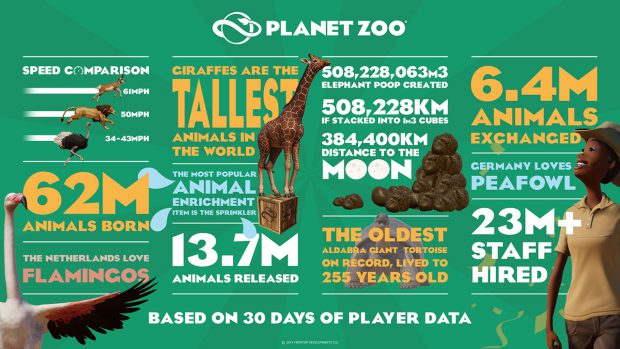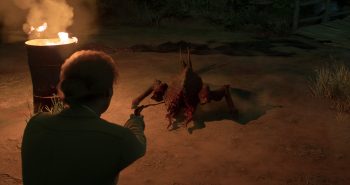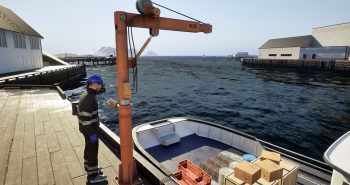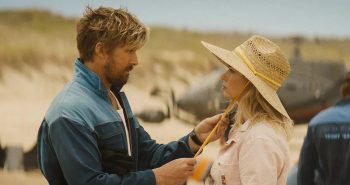Cambridge, UK – November 12, 2019 — Frontier Developments plc (AIM: FDEV) today announced the first PDLC for Planet Zoo, the Arctic Pack, will be available on Steam from December 17 for $9.99. Alongside the PDLC, a free update will add new features for existing players. Planet Zoo is available now on Steam with a RRP of $44.99, Planet Zoo Deluxe Edition RRP for $54.99 or the Planet Zoo Deluxe Upgrade Pack for $11.99.
No need to wrap up warm, players can explore a wintery wonderland with Planet Zoo’s first PDLC, Arctic Pack, out December 17. Featuring four new habitat animals, two new scenarios and hundreds of foliage and scenery items, the first Planet Zoo PDLC launches alongside a free update for existing players including a range of new features, improvements and fixes.
The graceful Arctic Wolf, majestic Polar Bear, wintery Reindeer and hardy Dall Sheep join the impressive list of habitat animals available to players to breed, research and raise within their hand crafted and unique zoos. Two new arctic themed scenarios will set a series of challenges, focusing on expanding and maintaining existing zoos while ensuring animal welfare and educating guests. The mountainous and snowy tundra biome, based in Norway and featuring the Aurora Sky, and the arid desert biome in Mexico, will challenge and delight players.
The PDLC launches alongside a free update containing a range of new features for existing players; a new aging slider to slow the animal lifecycle, immediate family members have been added to the animal info panels, new heat maps including crime and inbreeding, new nature assets, enrichment items and a range of fixes and improvements.
Frontier also shared a Planet Zoo stats and facts based on the first month of player data in a handy infographic, including;
- 62 million animals born
- 23 million staff hired
- 18.5 million enrichment items placed
- 13.7 million animals released into the wild
Dall Sheep
- Native to north-western North America, ranging from white to slate brown in colour and having curved, yellowish-brown horns
- The sheep inhabit the subarctic mountain ranges of Alaska, the Yukon Territory, the Mackenzie Mountains in the western Northwest Territories, and central and northern British Columbia
- Dall sheep are found in relatively dry country and try to stay in a special combination of open alpine ridges, meadows, and steep slopes with extremely rugged ground in the immediate vicinity, to allow escape from predators that cannot travel quickly through such terrain.
Polar Bear
- The polar bear is a large species of bear that lives in the Arctic Circle and the Sub Arctic. Their coat is completely white, with dark eyes and a dark nose
- Polar bears are the largest land carnivores in the world
- Polar bears do not need to drink as they can produce water through digesting seal blubber
- With the exception of a mother with her cubs, polar bears are solitary
Arctic Wolf
- Arctic wolves, also known as white wolves, are a large canid species that live in Northern Canada and Greenland. They are large pack predators that feed mainly on muskoxen and arctic hares, although they may also eat foxes, birds and bear cubs as well as scavenge carrion.
- Arctic wolves are larger and stockier than other species of wolves to enable them to withstand the harsh conditions in which they live
- Arctic wolves can withstand temperatures as low as –53oC
Reindeer
- The reindeer is a species of ungulate that lives throughout the Arctic and Sub Arctic
- The appearance of reindeer changes depending on where they are from and the time of year, but generally they have a brown and white coat and face with a white underside and muzzle, often with darker coloration on the snout.
- The North American reindeer (caribou) migrates up to 5000km, the furthest of any land mammal
- The most mature and dominant reindeer stags have the largest antlers
Norway>
- Players will head over to the Scandinavian fjords of Norway to build up a remote animal sanctuary, bringing new Arctic animals to their zoo, tending to their needs, and ensuring their habitats are suitable
Mexico
- Players will expand on an existing zoo that’s looking to bring a touch of frost to its guests, while learning how to keep native Arctic animals comfortable in a challenging hot climate






